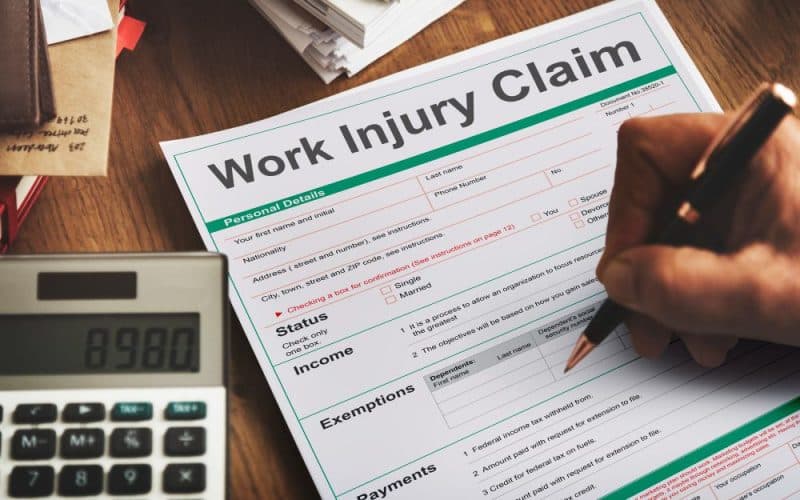Following an on-the-job injury or work-related illness, there’s a limited amount of time to report the incident and file a workers’ compensation claim. Failure to do so could result in a denial of workers’ compensation insurance benefits.
That’s why employers must train their employees to immediately report an injury at work. As the employer, you’re typically responsible for submitting a claim to your workers’ compensation insurer, but you’ll first need to gather details and documentation about the incident.
Workers’ compensation insurance provides coverage for employees who suffer work-related injuries or illnesses. It covers medical expenses, disability benefits, and lost wages for employees who are injured or become ill while performing their job duties. Most workers’ compensation programs are paid for by private insurers, from premiums paid by the individual employers. Each state has a Workers’ Compensation Board, a state agency that oversees the program and intervenes in disputes.
There are federal workers’ compensation programs that cover federal employees, longshore and harbor workers, and energy employees. Another federal program, the Black Lung Program, handles death and disability benefits for coal miners and their dependents.
Overview of workers’ compensation insurance
To protect your staff, workers’ compensation insurance is essential and is even a legal requirement in most states. It provides financial support and medical benefits to employees who are injured or who become sick due to their employment. In addition, it prevents you from paying costly expenses.
Workers’ compensation, commonly referred to as “workers’ comp,” is a government-mandated insurance program that provides benefits to workers who become injured or ill on the job or as a result of the job. It is effectively a disability insurance program for workers, providing cash benefits, healthcare benefits, or both to workers who suffer injury or illness as a direct result of their jobs.
It is your responsibility as a business owner to provide a safe work environment for your employees, but accidents and injuries may still happen.
Types of workers’ compensation insurance
The lack of federal standards for workers’ compensation has resulted in extremely varied policies for the same kinds of injuries from state to state.
Identical injuries can receive radically different kinds of compensation depending on where a worker resides. A paper by the Occupational Safety and Health Administration (OSHA) flatly calls workers’ compensation a “broken system,” and estimates that 50% of the costs of workplace injury and illness are borne by the individuals who suffer them. Low-wage and immigrant workers often don’t even apply for benefits.
Workers’ Compensation: Coverage A vs. Coverage B
There are two types of workers’ compensation coverage: Coverage A and Coverage B.
- Coverage A includes all of the state-mandated benefits that an injured or ill employee is entitled to receive from the employer’s insurance. It covers salary replacement payments as well as medical care, rehabilitation, and death benefits as necessary. All states except Texas have such benefits, although they vary widely from state to state and many states exclude some employees from eligibility.
- Coverage B pays benefits that exceed the minimums required by Coverage A. They usually are paid only as the result of a successful lawsuit brought by the employee for negligence or other misconduct by the employer.
Workers who accept workers’ compensation generally waive the right to sue their employers, agreeing to a no-fault contract in doing so. However, state legislation and court rulings in a number of states have restored the employees’ right to sue in various strictly defined circumstances.
Thus, an employer may opt to purchase a policy that combines Coverage A and Coverage B.
Steps to filing workers’ compensation insurance claims
While the workers’ compensation claims process can seem complicated, it can be broken down into five basic steps.
The employee reports an injury to their employer
As an employer, make sure your employees know that if they become ill or injured on the job, they need to inform you as soon as they are able.
Typically an injured employee is required to provide written notice, and most states set deadlines for reporting injuries. For example, the employer must be notified within 30 days in New York, while other states allow employees a year or more to report an injury.
A variety of injuries may qualify, such as slipping on a wet floor in the office and breaking an arm, or developing carpal tunnel syndrome from repetitive typing.
Some injuries may require immediate treatment at an emergency room or urgent care facility. Others may require a doctor’s visit for diagnosis and medical care. Depending on the state and the insurer, the employee may need to seek non-emergency treatment from a medical provider that’s part of the insurer’s network to receive benefits.
With injuries or illnesses that surface over time, such as mesothelioma (caused by exposure to asbestos), the employee should report the illness as soon as possible.
The employer guides the injured worker on necessary paperwork and next steps
Once you’ve been notified of an employee injury, you’ll need to provide your injured worker with information on their rights and workers’ comp benefits, as well as their return to work.
In most states, you’ll give your employee a workers’ comp claim form to fill out and return to you. This form will detail the nature of their injury, along with where, when, and how it occurred. You may also need to have your injured employee fill out a first report of injury form that you’ll submit to your state’s workers’ compensation board.
Which forms are required and who is responsible for completing them depends on the state where you and your employee are based, the type of illness or injury, and the insurer.
It’s a good business practice to include workers’ comp insurance information in your new hire employment packet to ensure your employees know their rights if they’re injured on the job. If you fail to provide this information, you could face a lawsuit.
The employer reports the injury and files the claim form
Usually, the employer is responsible for sending the claim form and all supporting documentation to the workers’ comp insurance carrier, but the employee’s doctor will also need to submit a medical report.
Additionally, you may be required to report the injury to your state’s division of workers’ compensation or workers’ comp board. This may apply to all workplace injuries, even if your employee is not seeking workers’ comp benefits.
How long does an employer have to file a workers’ comp claim? Typically, the employer has seven days to submit the claim to all necessary parties, including the insurer. This window can vary by state, so it’s important to check your state’s laws.
The insurer approves or denies the claim
Once the claim is filed, the insurer will either approve or deny the claim.
If a claim is approved:
Once a claim is approved, the insurer will inform the employer and contact the employee with payment details. At this point, the employee and their workers’ compensation lawyer (if any) may:
- Accept the insurance company’s payment offer, which may cover the costs of medical bills, medicine, disability payments, and a portion of lost wages.
- Negotiate for a lump-sum settlement or a larger structured settlement.
If a claim is denied:
If your workers’ comp insurer denies benefits, the employee has the option to:
- Request a reconsideration from the insurance carrier.
- File a formal appeal, usually through the state workers’ comp board or commission.
How do I know if my workers’ comp claim is approved?
Within a few weeks, you should receive a written notice of the outcome of your claim: approved or denied. If you haven’t heard from the insurance carrier handling your workers’ compensation case, contact the insurance adjuster or claims administrator directly.
The employee returns to work
Once an employee has recovered from an injury and can return to work, they’re required to provide written notice to both their employer and the insurance provider. Depending on the severity of the injury, the insurance company may have to pay permanent disability benefits.
Many employers choose to implement a formal return to work program, aimed at getting workers back to work and productive as quickly as possible. These programs may involve offering an injured worker modified duties, or training employees on other skills if they’re unable to resume their regular responsibilities.
When should you file workers’ compensation claims?
An employee’s injury or illness likely qualifies for workers’ compensation benefits and can file claims if it occurred on the job or within the scope of employment. This includes occupational illnesses or occupational diseases caused by exposure to harmful chemicals or other hazards while on the job.
In order to file workers’ compensation claims, all of the following must be true:
- You have an active workers’ compensation policy.
- The injured worker is an eligible employee of your business.
- Your employee became injured while at work or became ill due to work conditions.
What does Workers’ compensation insurance cover?
Medical expenses including hospital visits, medications, and emergency surgeries are all covered by workers’ compensation.
- Lost wages are partially covered when the employee needs time away from work to recover from a work-related illness or injury.
- Disability benefits are available if the injury caused a partial or permanent disability.
- Ongoing care costs, such as physical therapy, are covered by workers’ compensation.
- Death benefits typically include funeral costs and survivor benefits for the worker’s family.
Workers’ comp benefits are paid no matter who was at fault. And workers’ compensation laws typically prevent employees from suing their employers for a work-related injury or illness.
What does workers’ compensation insurance not cover?
Employees are covered for workers’ compensation regardless of the number of hours they work.
However, there are exclusions, which could result in a denied workers’ comp claim, including:
- Commuting: Traveling to and from work is typically excluded from workers’ comp coverage. A person may be covered if they’re in a company vehicle or don’t have a physical office, such as a traveling salesperson.
- Intoxication or substance abuse: Many states exclude workers’ compensation coverage if the injured person was intoxicated and that contributed to the injury.
- Workplace fight: If an injury happens during a fight with a colleague, workers’ compensation may not cover the injuries. One exception is if the fight was about work.
Why business owners should follow the workers’ compensation claims processes
It’s important to learn your state’s workers’ compensation laws and follow their requirements regarding the workers’ compensation process. Failure to do so may result in costly fines and penalties.
In addition to keeping an active workers’ compensation insurance policy, make sure you:
- Provide employees with accurate information on their rights and benefits.
- Report any injuries in accordance with state deadlines.
- Accurately classify employees and injuries.
- Don’t attempt to influence a medical provider’s diagnosis or treatment.
- Don’t appeal an approved claim without probable cause.
If you need workers’ comp coverage for your employees, compare quotes online to avoid penalties and business risks. Most small businesses can get workers’ comp coverage in 24 hours, depending on the state.
Recommended Articles
- WORKERS COMP SETTLEMENT: What Is It & How It Works
- Best Workers’ Compensation Insurance in Georgia 2023
- Top Best Workers’ Compensation Insurance Companies of 2023
- Best Workers Compensation Insurance Of 2023
- Workers Compensation Insurance Florida: The Ultimate Guide
- Florida Workers Compensation Exemption: 2023 Guide






